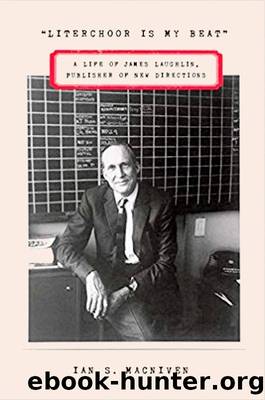Literchoor Is My Beat; A Life of James Laughlin, Publisher of New Directions by Ian S. MacNiven

Author:Ian S. MacNiven [MacNiven, Ian S.]
Language: eng
Format: epub
Tags: Arts & Disciplines, Autobiography, Biography, Editors, Journalists, Language, Non-Fiction, Publishers
ISBN: 9780374712433
Google: OVqYAwAAQBAJ
Publisher: Farrar, Straus and Giroux
Published: 2014-11-18T00:00:00+00:00
25
Missing a Few Beats
The Beat Generation … beat, meaning down and out but full of intense conviction.
—Jack Kerouac
With scant warning, Uncle Dicky died in December 1954, a devastating loss for his formidable spouse. According to a favorite niece, she “changed completely after she lost him and was very lonely.” One result was that Aunt Leila became even more possessive toward J, and his daily visits became more than ever the center of her life. There was also a shift in what a grand-niece called her “God-based reality,” a change from a life lived in the acceptance of an indwelling God toward a direct pursuit of the occult. Propelled by her great sorrow and loneliness, she attempted to communicate with Uncle Dicky through her spiritualist, Clara Sage, who had long been employing her otherworld contact, Lester, on Aunt Leila’s behalf. He assured Aunt Leila that Uncle Dicky was happy and “content” in his “new home.” Lester advised Aunt Leila on various “problems,” including “M.”—Maria Britneva—and J himself, but he failed to give advance warning when Maria suddenly arrived unheralded in New York. It would be a mistake to write off Maria as a fortune hunter: she was proudly independent and resented her need at times to accept gifts. Tennessee said that “the help she needs is artistic and emotional, not material, primarily.” She had wanted to become a dancer and, when her physique failed her, an actress; however, she was too indelibly herself to assume any stage role convincingly.
For his part, J was profoundly distressed by Maria’s materialization. “As you have gathered,” J wrote to Tennessee, “all this business with Maria is driving me half crazy.” He paid anonymously for her to see a psychiatrist, but Maria was able to “worm it out of the doctor” where the funding for the sessions originated, and J in turn learned from the man that her motivation was solely to “alter her personality so that I would like her.” Gertrude, meanwhile, fled to Key West during the Christmas holidays to visit Tennessee and Frank Merlo. The scenario was threatening to turn into a play by Tennessee.
In early January 1955, Audrey Wood sent J a typescript of Tennessee’s new play, Cat on a Hot Tin Roof. “Frankly, I am still shaking all over,” J wrote to the author after reading it, and no wonder: the Cat of the title was based on Maria. “It is really shattering, a small atom bomb, and in parts as strange and true as Dostoievski.” “Brick is a terrific character,” J said, whose relationship with Maggie the Cat is doomed by his homosexuality. Did Tenn see in J’s inability to cope with Maria’s stupendous vitality a model for the Brick/Maggie tensions? J was no homosexual, yet he had long realized that he was attractive to men as well as to women, and there was an uncanny reciprocal understanding between J and the gay dramatist, an empathy that sustained their friendship. J was fascinated by the doppelgänger, and despite their manifest dissimilarities Tennessee was in a sense his double.
Download
This site does not store any files on its server. We only index and link to content provided by other sites. Please contact the content providers to delete copyright contents if any and email us, we'll remove relevant links or contents immediately.
Hit Refresh by Satya Nadella(8854)
When Breath Becomes Air by Paul Kalanithi(8038)
The Girl Without a Voice by Casey Watson(7602)
A Court of Wings and Ruin by Sarah J. Maas(7252)
Do No Harm Stories of Life, Death and Brain Surgery by Henry Marsh(6683)
Shoe Dog by Phil Knight(4884)
Hunger by Roxane Gay(4677)
A Higher Loyalty: Truth, Lies, and Leadership by James Comey(4550)
The Rules Do Not Apply by Ariel Levy(4523)
Everything Happens for a Reason by Kate Bowler(4474)
Tuesdays with Morrie by Mitch Albom(4394)
The Immortal Life of Henrietta Lacks by Rebecca Skloot(4253)
How to Change Your Mind by Michael Pollan(4112)
Millionaire: The Philanderer, Gambler, and Duelist Who Invented Modern Finance by Janet Gleeson(4092)
All Creatures Great and Small by James Herriot(3984)
Tokyo Vice: An American Reporter on the Police Beat in Japan by Jake Adelstein(3860)
Elon Musk by Ashlee Vance(3854)
The Money Culture by Michael Lewis(3846)
Man and His Symbols by Carl Gustav Jung(3844)
